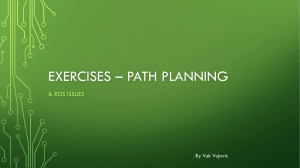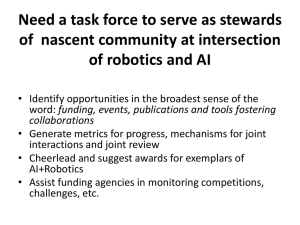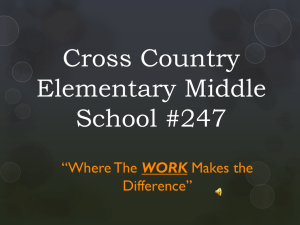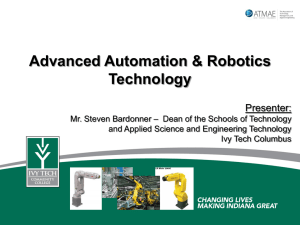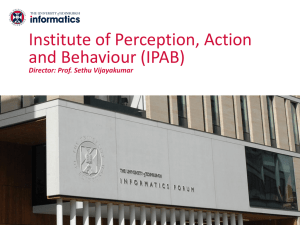Singh-2013_CASE_raas
advertisement
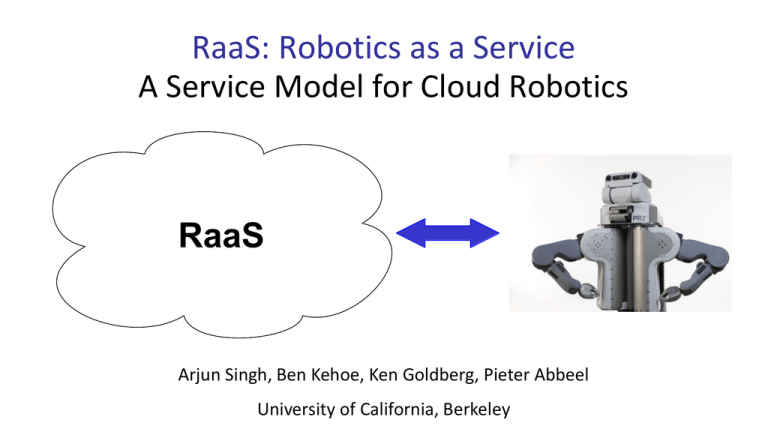
RaaS: Robotics as a Service A Service Model for Cloud Robotics RaaS Arjun Singh, Ben Kehoe, Ken Goldberg, Pieter Abbeel University of California, Berkeley Example Use Case Objects coming down conveyer belt Identify each object, pick it up, and place into correct bin Low-level control Object recognition Grasp planning Motion planning Drawing: Ketrina Yim How to Solve It with ROS Acquire computing hardware Install ROS and relevant packages Execute and maintain software and computing hardware Drawing: Ketrina Yim Pros and Cons of ROS Huge positive impact on robotics (especially sharing) Core great for messaging, lowlevel control – components that make a robot operating system Packages required for barebones ROS installation Asking it to do too much All code for everything robotics related Packages required for full ROS installation Pros and Cons of ROS Intimidating for non-roboticists Nontrivial to set up secure distributed networking with ROS -need to understand VPNs, have control over network environment, etc. Dependencies can turn into a nightmare (especially with multiple ROS versions) Computing Environment has Changed ROS design started in 2006 – a lot has changed! Cloud computing: Easy access to vast numbers of machines Software engineering: Serviceoriented architectures and Software as a Service E.g. Google Docs vs. Microsoft Office Example Services – Motion Planning Start State Motion Planning Service Output Trajectory Goal State Example Services – Object Recognition Object Recognition Service Input Scene Detected Objects and Poses Our Idea: Robotics as a Service (RaaS) Publish algorithms as services Data Collectors Consume services on your robot Object Dataset 1 Object Dataset 2 RaaS Collaborative data collection Object Recognition Motion Planning 1 Grasp Planning Algorithm Developers Motion Planning 2 Algorithm Users Related Work Open-Source Tools Cloud Robotics Rapyuta (www.rapyuta.org/) Robotics Platform as a Service MoveIt! (Sucan and Chitta) Motion planning Rocon (www.robotconcert.org/) Higher-level orchestration GraspIt! (Ciocarlie and Miller) Grasp planning Goldberg et al. 1995 Networked robotics OpenCV (Bradski) Computer vision Arumugam et al. 2010 Cloud computing for robots OpenRAVE (Diankov) Motion planning Ciocarlie et al. 2010 Big data for robotics Ladon (www.ladonize.org) Web service framework Kuffner 2010 Cloud-enabled robots Remy and Blake 2011 Service-oriented robotics Commercial Products Blake et al. 2011 Service-oriented robotics Mashape Index of service APIs Waibel et al. 2011 Shared knowledge PiCloud Move computation into cloud Why RaaS? Limited Resources Code Sharing Encapsulation Parallelism Common Interfaces Why RaaS? Limited Resources Code Sharing Encapsulation Parallelism Common Interfaces Some robotic platforms have limited onboard computation (e.g. Baxter) Can’t run sophisticated robotics algorithms Need offboard computation – use the cloud or buy computers Services give a straightforward way to move computation to the cloud Photo: David Yellen for IEEE Spectrum Why RaaS? Limited Resources Code Sharing Encapsulation Parallelism Common Interfaces Spend months working on your algorithm, finally finish it, and you want to share it Need to figure out what all the dependencies are Need to document how to install everything Need to document how to use your code Don’t have time for any of these Packaged service: only worry about API users interact with Why RaaS? Limited Resources Code Sharing Encapsulation Robotics requires integrating many different components Vision, NLP, control, messaging, planning, grasping, etc. – each alone is complex Parallelism Common Interfaces Object Detection: Dependency A 1.0 Dependency B 2.1 Dependency C 2.5 Motion Planning: Dependency B 2.1 Dependency C 3.2 Huge number of dependencies – something is bound to conflict Services force encapsulation of components Use object detection and planning systems without worrying about conflicts Object Detection: Dependency A 1.0 Dependency B 2.1 Dependency C 2.5 Motion Planning: Dependency B 2.1 Dependency C 3.2 Why RaaS? Limited Resources Code Sharing Service: natural interface for parallelizing computation Insulates user from managing parallelism Automatically run multiple instances of a service on multiple machines Encapsulation Parallelism Common Interfaces Why RaaS? Limited Resources Code Sharing Encapsulation Parallelism Common Interfaces Easy benchmarking and comparison Use common interfaces when defining services E.g. object recognition systems Input: Image Output: List of object identities Can’t expect researchers to implement interfaces at a library level Swap out services RaaS Workflow RaaS Workflow – Algorithm Developers RaaS Object Recognition Motion Planning 1 Grasp Planning Algorithm Developers Motion Planning 2 RaaS Workflow – Algorithm Developers Write your usual code Wrap with service code Launch Machine on Amazon EC2 Install dependencies + code Create Amazon Machine Image (AMI) Publish your service Create Amazon Machine Image RaaS Workflow – Algorithm Developers Make creating a web service as simple as possible Ignore HTTP, serialization, encoding, webservers, etc. Rich set of types available for service methods Strings, floats, integers, binary blobs, raw files, timestamps, durations, poses, transformations, vectors, matrices, images, point clouds Create your own Can serve ROS nodes as web services RaaS Workflow – Algorithm Users Motion Planning 1 Grasp Planning Object Recognition RaaS Motion Planning 2 Grasp Planning Algorithm Users RaaS Workflow – Algorithm Users Choose services Service Definition: Launch machines in the cloud Connect to machine and use services Detect objects in images, plan motions, etc. Object Recognition Service Input Scene Client Code: Detected Objects and Poses RaaS Workflow – Algorithm Users Compare different algorithms implementing the same interface by changing a single URL Again, ignore serialization, encoding/decoding, HTTP, etc. – use like an ordinary function call Use web-service-based ROS Nodes as if they were local ROS Nodes How to Solve It with RaaS No need to worry about computing hardware Install barebones ROS – (i.e. only messaging, low-level control, etc.) Use object recognition, motion planning, grasp planning services from RaaS RaaS complements ROS Drawing: Ketrina Yim Collaborative Data Collection – Example Ten camera rig with controllable turntable High quality 3d models from about 600 images in 5 minutes of human time Ship us an object, we upload model to cloud, you can recognize it in images Roadmap (Almost) Complete (pre-alpha) Future Work Service framework implemented for Python Linux containers rather than Amazon Machine Images Service directory implemented for EC2 Need to polish up rough edges and automate tedious steps Can then run services anywhere – in your lab or in the cloud Infrastructure for other programming languages Data collection APIs Interested? Email us! arjun@eecs.berkeley.edu
